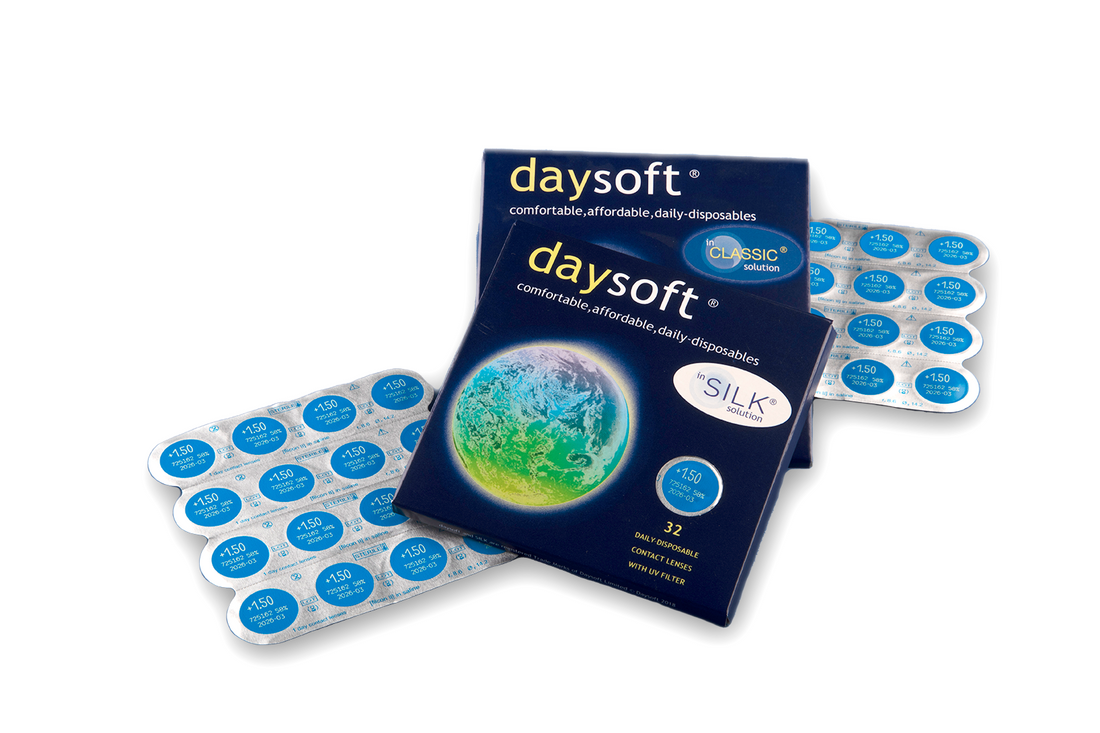Whether you’ve been wearing contact lenses for years, or you're wearing them for the very first time, you’ll need a contact lens prescription (often referred to as a specification) to know exactly what correction is needed to your vision.
You’ll get your contact lens prescription when you visit your optician. You can also find it on the side of the contact lens box or on the blister packs that contain your lenses. But what do all the letters, numbers and symbols on the prescription actually mean? Our daysoft® team is on hand to explain all.
Your Contact Lens Prescription Explained
A contact lens prescription in the UK is typically made-up of the following measurements: base curve, diameter and power (or sphere). The requirements for your right and left eyes may vary, so their prescriptions will be listed separately.
There may be additional specifications for Axis and Cylinder if you have an astigmatism (caused by irregular curvature of the eye). If that’s the case, daysoft® isn’t the right option for you. Our lenses have a spherical design and we don’t currently have a toric version to correct astigmatism.
Similarly, if you have presbyopia with extra specifications for Addition and Dominant, daysoft® isn’t the right option for you.

So what do each of these contact lens prescription figures mean?
The three main measurements you’ll find on your contact lens prescription are:
Base curve (BC)
The base curve value (in millimetres) indicates how curved your contact lens must be to meet the curve of your eye.
Diameter (DIA)
The Diameter measurement determines the width that best fits your eye - in other words, it’s the size of the contact lens from one edge to the other. It’s written in millimetres and is used to ensure the contact lens covers the correct parts of your eye.
Power/Sphere (PWR/SPH)
The Power (sometimes called the Sphere) figure records the power of the lens needed to correct your long or short-sightedness.
If you have short-sightedness (myopia) the Power/Sphere figure will begin with a minus sign (-). If you have long-sightedness (hyperopia) it will begin with a plus sign (+). The figure that follows will be a number that goes-up from 0 in measurements of 0.25 Dioptres (D). The higher the number, the stronger your prescription.
Other Contact Lens Prescription Figures
If you require toric lenses to correct astigmatism or need presbyopia/multifocal correction you will find some additional figures on your contact lens prescription. Daysoft is currently unable to provide contact lenses to meet these prescription requirements. But for your information, here’s what they mean:
Cylinder (CYL)
The Cylinder measurement will be shown on your prescription if you have astigmatism. It shows the severity of the astigmatism and indicates how curved the structures in your eye are. If this section of your prescription is empty you don’t have astigmatism.
Axis (AX)
The Axis figure will be a value between 0 and 180 degrees. It determines the angle of correction required on your lens in order for you to see clearly. Again, if this section of your prescription is empty you don’t have astigmatism.
Addition (ADD)
The Addition figure is the magnifying power added to multifocal contact lenses to enable you to see clearly at a close distance. This will either be recorded as High, Low, or Medium, or it will be shown as a number between 0.50 and 3.00. It will only appear on your contact lens prescription if you have presbyopia.
Dominant
If you require multifocal or bifocal contact lenses, the correction is determined by a dominant and non-dominant eye. The letters “D” and “N” on your prescription show which eye is which.
Do I need a contact lens prescription in the UK?
To buy contact lenses in the UK, it is necessary to have a valid prescription provided by an optician. This confirms that your eyes are suitable for using contact lenses and provides the details you need to order the correct lenses. Contact lens prescriptions are normally valid for up to 2 years from the date of issue although sometimes your optician may give an earlier expiry date for clinical reasons.
You should automatically be supplied with a prescription after a contact lens fitting with your optician. In the UK it’s your legal right to have a copy of your prescription, so if you didn’t receive one at your last fitting, just contact your optician and ask.

Is a contact lens prescription the same as a glasses prescription?
In short, no, your contact lens prescription is not the same as your glasses prescription, and a glasses prescription cannot be used to purchase contact lenses.
This is because of the position in which the lenses sit. Contact lenses sit on the surface of your eye, whereas glasses lenses sit further away. As such, the required power of the lenses will be different.
The cylinder, axis and sphere values in your glasses prescription need to be recalculated by an optician for your contact lenses to work effectively. You’ll also need a specific contact lens prescription to have information about the base curve and diameter measurements of your lenses.
Can I buy daysoft® contact lenses without having my prescription verified?
When you order your daysoft® contact lenses, and accept our Terms and Conditions, you are confirming you have a valid contact lens prescription and that you haven't experienced any eye problems since that prescription was issued. Take a look at our T&Cs for more information.
Having a valid prescription is essential, but we trust you to take responsibility for your own eye health and don’t need to see a physical copy of your prescription to send you your lenses.



